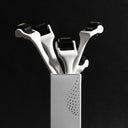Are you struggling with hair loss, thinning, or slow growth? You're not alone! Many people face these challenges daily, and finding the right solution can be daunting.
The key to healthy hair growth lies in a well-nourished and stimulated scalp.
That's why we've compiled a list of 13 proven scalp treatments to help you revitalize your hair follicles, promote growth, and nourish your strands.
From all-natural remedies to the latest innovations in hair care, this comprehensive guide will introduce you to the most effective solutions to unlock your hair's full potential.
So, let's dive in and explore the path to luscious, thick, and healthy locks!
Busy? Here's our pick for the best scalp treatment for hair growth.
Table of content
Why scalp treatment is important for hair growth?

Scalp treatment is crucial for hair growth because the health of your scalp directly influences the overall condition and growth potential of your hair.
A well-nourished and properly stimulated scalp provides an optimal environment for hair follicles, ensuring they receive the necessary nutrients and oxygen to produce strong, healthy strands.
Scalp treatments work to remove buildup, improve circulation, and maintain the right balance of natural oils, which promotes growth and prevents hair loss.
Moreover, a healthy scalp is less susceptible to issues like dandruff, itchiness, and inflammation, all of which can impede hair growth.
By investing in the right scalp treatments, you're setting the foundation for lustrous, thick, and resilient locks that are less prone to breakage and thinning.
As your leading source for hair health information over the past 4 years, we never compromise on accuracy. When it comes to your health, you deserve information you can truly rely on - and earning your trust is our top priority.
Here's how Scandinavian Biolabs ensures every piece of content meets the highest standards of accuracy and integrity:
- Credentialed Experts: Our reviewers are actively practicing doctors and medical researchers
- Stringent Reviews: Content undergoes rigorous editing by subject specialists and review by a practicing doctor.
- Evidence-Based: We rely on well-established research from trusted scientific sources like peer-reviewed journals and health authorities.
- Full Transparency: Our editorial standards, writer credentials, reviewer credentials, correction process, and funding are all publicly documented.
- Independent Voice: While we do promote products, we operate in a vacuum to business operations. Our main goal is just an unwavering commitment to providing medically-sound guidance.
You can count on Scandinavian Biolabs to consistently deliver the trustworthy health information you deserve. Read our Editorial Standards.
How to pick the best scalp treatment for your hair?
Choosing the right scalp treatment depends on your hair type and specific needs. Here's a quick guide:
- Oily hair: Opt for treatments with tea tree, lavender, or peppermint oil to regulate sebum production.
- Dry hair: Seek treatments with coconut, argan, or jojoba oil for hydration and nourishment.
- Dandruff-prone hair: Look for ingredients like tea tree oil, selenium sulfide, or pyrithione zinc for their antifungal and antibacterial properties.
- Sensitive scalp: Choose gentle ingredients like aloe vera, chamomile, or calendula to soothe and reduce inflammation.
- Color-treated hair: Select treatments specifically formulated for colored hair to protect hair color and provide nourishment.
13 best scalp treatments for hair growth
Discover the top 15 scalp treatments that can effectively stimulate hair growth and rejuvenate your hair, offering solutions for various hair concerns and promoting overall scalp health.
1. Scandinavian Biolabs Hair Growth Routine

Attention all discerning customers!
If you're aiming to treat hair loss effectively, trust the Scandinavian Biolabs Hair Growth Routine for reliable hair regrowth solutions. Our science-backed formula is specifically designed to help combat hair loss and stimulate new growth, all while keeping your natural hair growth healthy and strong.
Our star ingredient, the Bio-Pilixin® formula, is clinically proven to enhance hair regrowth and density, showing overwhelmingly positive results in treating hair loss.
In fact, over 70% of our customers witnessed a significant increase in hair density and thickness, effectively treating hair loss, with 97% observing a slowdown in hair loss.
Our formula stands out for its unique blend of essential nutrients and natural ingredients, meticulously chosen to optimize hair growth and scalp health, thereby effectively slowing hair loss.
Our ingredients, including Capilia Longa, niacinamide, aloe vera, amino acids, vanillyl butyl ether, and zinc PCA, work in synergy to create an ideal environment for hair growth, nourishing your hair from root to tip.
Our commitment to science and research doesn't stop there. We're constantly updating our formula and exploring new ways to enhance its effectiveness, ensuring that our customers receive the best possible results.
Don't just take our word for it – read the reviews from our satisfied customers. They've experienced first-hand the transformative effects of our Hair Growth Routine and are eager to share their success stories with you.
So if you're ready to say goodbye to hair loss and hello to a healthier, stronger mane, try Scandinavian Biolabs Hair Growth Routine today. Trust us – your hair will thank you.
2. Minoxidil
Minoxidil is a topical treatment applied to the scalp to promote hair growth by widening blood vessels and increasing blood flow to hair follicles.
Available in 2% or 5% solutions or foam, it can cause side effects like scalp irritation or more serious issues like chest pain in rare cases.
Always follow instructions and consult a healthcare provider for any concerns.
Read this: The 7 Best Natural and Drug Alternatives To Minoxidil
3. Laser therapy
Low-level laser therapy (LLLT) uses red or near-infrared light to stimulate hair follicles, improving blood flow and cellular activity in the scalp.
It's a safe method with minimal side effects, often used alone or with other treatments to enhance hair growth.
4. Platelet-rich plasma (PRP) therapy
PRP therapy involves injecting a concentration of the patient's own platelets into the scalp to stimulate hair follicles.
It's generally safe, with minimal side effects, but may require multiple sessions for best results.
5. Scalp massage

Regular scalp massage can improve hair thickness and growth by stretching dermal papilla cells.
A 2019 study suggests daily massages of 4 minutes for 24 weeks can yield positive results, along with stress relief.
6. Aloe vera
Aloe vera, known for its soothing properties, can treat dry scalp and dandruff, unblock hair follicles, and promote hair health. It's available in pure gel form or as an ingredient in shampoos and conditioners.
The Scandinavian Biolabs Hair Growth Routine also contains aloe vera, one of the many natural ingredients supporting hair growth and health.
7. Microneedling
Microneedling is a process that involves using a dermaroller to create tiny, controlled injuries on the scalp. These small injuries stimulate the scalp's natural healing process and encourage the production of collagen and new hair growth.
The needles on the dermaroller penetrate the skin, creating tiny channels that allow topical treatments like minoxidil and platelet-rich plasma to penetrate the scalp more deeply.
A study conducted in 2013 found that microneedling can be effective in treating androgenetic alopecia, a common form of hair loss.
While microneedling can be effective in promoting hair growth, it can also have side effects, such as scalp irritation and infection, if not done correctly.
Read this: Derma Roller For Hair Growth
8. Mesotherapy
This non-surgical treatment involves injecting a mix of vitamins, minerals, amino acids, and medications into the scalp to stimulate hair growth. It's safe and effective but may require multiple sessions.
10. Ginseng
Ginseng is a natural supplement that can help promote hair growth by stimulating hair follicles. The active components of ginseng are ginsenosides, which have been found to have a positive effect on hair.
While research on the topic is limited, a 2018 research review showed some promising results. It's important to always follow the recommended dosage when taking ginseng supplements and be aware of any possible side effects.
12. Hair serums
These products, like the Bio Pilixin Activation Serum, contain concentrated active ingredients like caffeine, biotin, and arginine to nourish hair follicles, reduce hair loss, and protect against environmental damage.
13. Hair nutrient tablets
Hair nutrient tablets are supplements that are designed to provide essential nutrients that can support healthy hair growth.
These tablets are usually formulated with a blend of vitamins, minerals, and other nutrients such as biotin, folic acid, iron, and zinc which are known to promote hair growth and prevent hair loss.
Hair nutrient tablets can be especially helpful for people who may not be getting enough of these nutrients from their diet or who have a medical condition that affects nutrient absorption.
One example of a hair nutrient tablet is the Hair Nutrient Tablets by Scandinavian Biolabs, which contains a blend of essential vitamins and minerals that encourage hair growth and improve hair quality.
14. Onion juice
Onion juice has been found to be a natural remedy for promoting hair growth and treating patchy alopecia areata.
While its strong smell may be off-putting to some, its potential benefits are worth considering.
Research has shown that onion juice can improve circulation and lead to improved keratinocyte growth factor, which plays a vital role in hair follicle development and growth.
Applying onion juice to the scalp can be done by blending or juicing onions and then applying the resulting liquid to the scalp and hair.
15. Hair transplant surgery

This is an option for advanced hair loss, where hair follicles are transplanted from a donor area to a balding area.
It's expensive, time-consuming, and may require multiple sessions, but can offer permanent results.
Read this: The 12 Best Natural and Drug Hair Transplant Alternatives
How should you use these treatments at home?
Here are some tips on how to use scalp growth treatment at home:
- Cleanse your scalp: Before applying the scalp growth treatment, it is important to cleanse your scalp thoroughly to remove any dirt, oil, or product buildup. Use a mild shampoo and warm water to wash your hair and scalp. Gently massage your scalp with your fingertips to stimulate blood flow and loosen any dead skin cells.
- Apply the treatment: Apply the scalp growth treatment to your scalp, following the instructions on the label. Depending on the product, you may need to apply the treatment to your entire scalp or only to the areas that need extra attention. Use your fingertips to massage the treatment into your scalp, focusing on the areas where you want to promote hair growth.
- Leave the treatment on: After applying the treatment, leave it on for the recommended time, as specified on the label. Some treatments may need to be left on overnight, while others can be rinsed off after a few minutes. Follow the instructions carefully to ensure that you get the maximum benefit from the treatment.
- Rinse and style: After the recommended time has passed, rinse your scalp thoroughly with warm water to remove the treatment. Follow up with a conditioner if needed, and then style your hair as usual.
- Be consistent: To see the best results, it is important to be consistent with your scalp growth treatment. Follow the recommended usage frequency, whether that's once a week or every other day, and be patient as it can take some time to see visible improvements.
Conclusion
There are a variety of scalp treatments available that can help promote healthy hair growth. From natural remedies like aloe vera and onion juice to medical treatments like minoxidil and hair transplant surgery, there are options to suit every budget and preference.
By prioritizing scalp health and using the right combination of treatments, achieving the luscious locks of your dreams is possible.
However, it's important to always follow the recommended dosage and instructions for each treatment and to speak with a healthcare professional if you experience any concerning symptoms or side effects.
Remember that healthy hair starts with a healthy scalp, so take the time to nurture and care for your scalp to create the perfect environment for your hair to thrive.
FAQs
What are some common scalp growth treatment myths?
Here are some of the most common myths and the truth behind them:
Myth #1: Scalp growth treatments can cure baldness.
Truth: While scalp growth treatments can help promote hair growth and reduce hair loss, they cannot cure baldness. Baldness is usually caused by genetic factors, and scalp growth treatments may not be effective in all cases.
Myth #2: Scalp growth treatments work overnight.
Truth: It takes time to see the effects of scalp growth treatments. Results may vary depending on the product and individual hair and scalp conditions. It may take several weeks or even months to see noticeable improvements in hair growth and scalp health.
Myth #3: Scalp growth treatments are only for people with hair loss.
Truth: Scalp growth treatments are beneficial for anyone who wants to maintain a healthy scalp and promote hair growth. They can help prevent hair loss, stimulate hair growth, and improve the overall health of your scalp and hair.
Myth #4: Natural scalp growth treatments are always better than synthetic ones.
Truth: While natural scalp growth treatments can be effective, synthetic ones can also work well. The key is to choose a treatment that is suitable for your hair and scalp condition and follow the recommended usage instructions.
Myth #5: Scalp growth treatments are only for women.
Truth: Scalp growth treatments are beneficial for both men and women. Hair loss and scalp issues can affect people of all genders and ages, and scalp growth treatments can help improve the health of anyone's scalp and hair.
Are there any potential side effects of scalp treatments?
While most scalp treatments are safe and well-tolerated, some treatments may have potential side effects such as scalp irritation, itching, dryness, or in rare cases, more serious side effects such as chest pain or irregular heartbeat. It's important to follow the instructions carefully and speak with a healthcare provider if you experience any concerning symptoms.
How long does it take for scalp treatments to show results?
The time it takes for scalp treatments to show results varies depending on the type of treatment and the individual. Some treatments, such as minoxidil, can show results in as little as 2-3 months, while others may take longer. It's important to be patient and consistent with your treatment regimen.
Can scalp serums help regrow hair?
Yes, some scalp serums are formulated with ingredients that can promote hair growth and reduce hair loss. These serums work by nourishing the hair follicles and creating a healthy scalp environment, stimulating hair growth and preventing further hair loss.
Can scalp treatments lead to unwanted hair growth?
It's unlikely that scalp treatments will lead to unwanted hair growth. Most scalp treatments are designed to improve the overall health of the scalp and hair and do not contain ingredients that promote hair growth in areas that are not desired.
Can scalp treatments help with female pattern hair loss?
Yes, scalp treatments can be helpful for female pattern hair loss. Many scalp treatments are formulated with ingredients that can promote hair growth and reduce hair loss, such as biotin, caffeine, and arginine. These ingredients can help create a healthy scalp environment and stimulate hair growth.
Can dead skin cells on the scalp cause hair thinning?
Yes, dead skin cells on the scalp can contribute to hair thinning. When dead skin cells build up on the scalp, they can clog hair follicles and prevent hair from growing properly. Regular scalp exfoliation can help remove dead skin cells and improve hair thickness and growth.
Can scalp treatments help with patchy hair loss?
Yes, scalp treatments can be helpful for patchy hair loss. Many scalp treatments contain ingredients that can promote hair growth and reduce hair loss, such as minoxidil, platelet-rich plasma, and laser therapy. These treatments can help stimulate hair growth in areas where hair loss is occurring.
Read more:
- Dutasteride vs. Finasteride: Which One Is Better?
- Does Masturbation Cause Hair Fall? Everything You Need to Know!
- 16 Potential Side Effects Of Minoxidil For Women
References:
- https://www.ncbi.nlm.nih.gov/pmc/articles/PMC4740347/
- https://onlinelibrary.wiley.com/doi/abs/10.1046/j.1524-475X.1998.60605.x
- https://www.ncbi.nlm.nih.gov/pmc/articles/PMC4387693/
- https://www.nature.com/articles/s41598-021-86454-1
- https://www.ncbi.nlm.nih.gov/pmc/articles/PMC6163201/
- https://www.ncbi.nlm.nih.gov/pmc/articles/PMC4350143/
- https://onlinelibrary.wiley.com/doi/abs/10.1111/j.1346-8138.2002.tb00277.x?sid=nlm%3Apubmed











